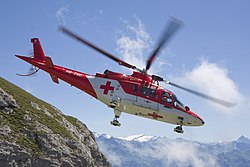Onset and recovery
During forward flight, the pitch angle – and therefore the angle of attack – of the rotor blades is increased while blades are retreating (that is moving backwards) and decreased while they are advancing; this is to compensate for the variation of the blades' speed relative to the air, with the aim of maintaining the rotor's lift distribution as uniform as possible. A higher angle of attack on the retreating blades results in a higher load on the servos, and on helicopters with the main rotor turning clockwise, when seen from above, this means that the blades on the right-hand side of the helicopter are generally more heavily loaded than the ones on the left. [6] : 30
Therefore, on clockwise-turning rotors, the right servo will reach its maximum design load first, and if the manoeuvring persists, the lift on the right side of the rotor disk will become insufficient, creating a rolling moment to the right. [2] Gyroscopic effects will then cause the helicopter’s nose to pitch up. [6] : 31 The way servo transparency manifests itself, with pitch-up and roll towards the retreating blades, is therefore similar to a retreating blade stall, although the two are distinct phenomena. [1]
The helicopter's natural response to servo transparency is to a degree self-correcting, in that the pitch-up normally results in a reduction of airspeed, collective pitch, and rotor loading, which within a few seconds allow the servos to regain effectiveness. [2] However, if a helicopters encounters servo transparency while in a turn towards the blades' retreating side, there is the risk that the bank angle could significantly increase and lead to loss of control, before an unsuspecting pilot has a chance to recognise the phenomenon and take corrective action. [6] : 41
When encountering servo transparency conditions, pilots are advised to immediately reduce the severity of the manoeuvre by following the controls movements, which allows the collective pitch to decrease naturally, thus lowering the rotor loading. The tendency to roll towards the retreating blades should be countered smoothly, to avoid abrupt roll inputs in the opposite direction once servo effectiveness is restored. [2]


